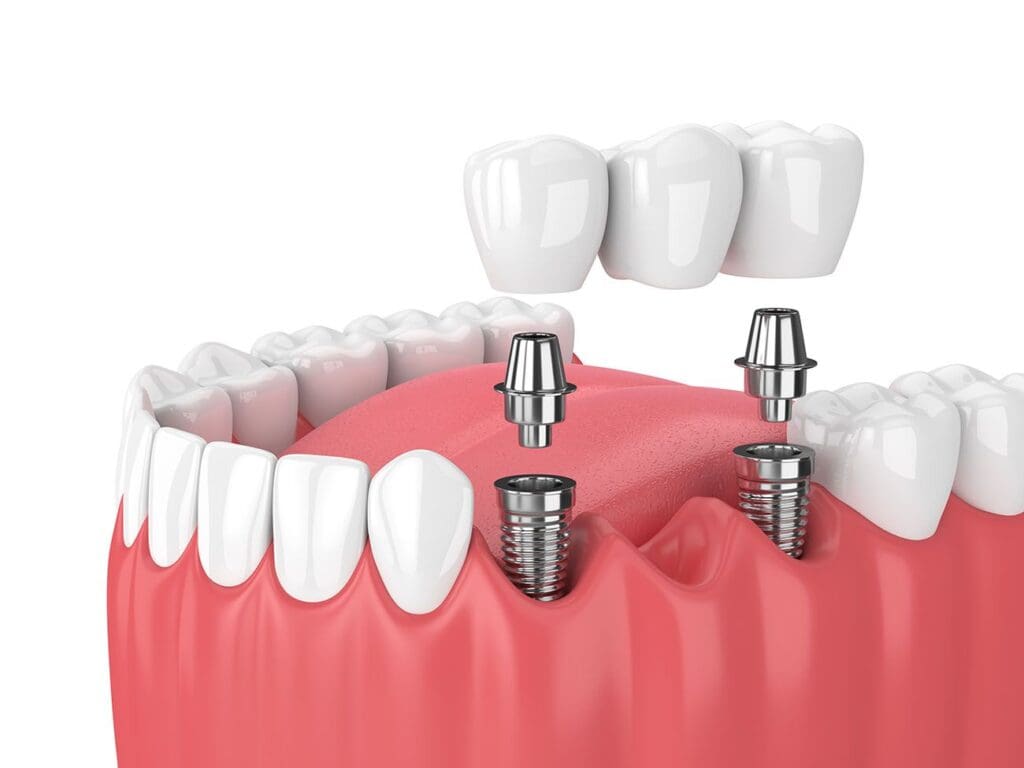A dental bridge is a series of artificial teeth. The bridgework is supported by an anchor on either side of the gap to hold the false tooth in place. With a bridge, we can restore one or more consecutive missing teeth. Joseph P. Cavallo offers dental bridge treatment in Woodbridge, VA. Dental bridge treatments are part of our restorative dentistry services.
A bridge uses the support of natural teeth, dental implants, or a combination of the two. When natural teeth support the bridgework, we place a dental crown for additional support and stability.

The Benefits of Dental Bridges
Dental bridges offer several benefits for patients missing one or more teeth. Of course, bridges fill the gap of your missing teeth. However, they can provide numerous benefits to your oral health.
Prevent Shifting Teeth
When a tooth is missing, the nearby teeth can gradually shift into the empty space. Bridges fill this gap and prevent this shifting. It can prevent misalignment and bite problems.
Protect Remaining Teeth
Bridges distribute the forces of your bite evenly across all of your teeth. This reduces the stress on your surrounding teeth. Using bridges to restore your smile helps prevent premature wear and tear.
Preserve Jaw Structure
Bridges help maintain the shape of your face by preventing the remaining teeth from shifting into the empty space. This can prevent issues like jaw misalignment and TMJ disorders.
Types of Dental Bridges
Multiple types of bridges are available to patients with missing teeth:
Traditional Bridge
The most common type is a traditional dental bridge. It consists of one or more artificial teeth (called pontics) held in place by dental crowns on the natural teeth next to the gap. These neighboring teeth, called abutment teeth, need to be prepared by removing some enamel to make room for the crowns. Traditional bridges are strong and work well for replacing molars.
Cantilever Bridge
This is similar to a traditional bridge but is supported by a crown on only one side of the gap. Cantilever bridges benefit patients with only one natural tooth next to the missing tooth space. Dentists place these bridges in areas of the mouth with less bite pressure because they can create extra force on the supporting tooth.
Maryland Bonded Bridge
A Maryland bridge uses a metal or porcelain framework with “wings” that are bonded to the backs of the natural teeth on either side of the gap. Unlike traditional bridges, Maryland bridges don’t require crowns or as much alteration of the neighboring teeth. However, they are not as strong and are typically used for front teeth.
Implant-Supported Bridge
An implant-supported bridge is anchored by dental implants instead of crowns or frameworks. Implants are surgically placed in the jawbone to provide a strong, stable base. This type of bridge is ideal for patients missing multiple teeth and offers a more permanent and durable solution.
Dental Bridge Treatment in Woodbridge, VA
A dental bridge is a viable treatment option for anyone with one or more missing teeth. They may be either fixed or removable, and our dentist can help you choose which type is right for you.
We follow a simple process for treatment with dental bridges. This process begins with a comprehensive evaluation to examine the health of the teeth, gums, jaw joints, and other support structures. You may have an existing dental bridge or teeth that need extraction. Regardless of your condition, the dentist will create a personalized treatment plan that fits your needs, goals, and budget.
The dental bridge will be fabricated in a dental laboratory. You may have a temporary bridge to wear in the intermediate time period. In approximately 2 to 3 weeks from your initial visit, you will return so we can fit the final restoration.
How to Care for a Dental Bridge
Taking care of your dental bridge is important to keep it clean and to maintain your oral health. Here’s how to take care of your dental bridge properly:
Brush Your Teeth
Just like your natural teeth, you should brush your dental bridge at least twice a day. Use a soft-bristled toothbrush and fluoride toothpaste to gently clean your teeth and the bridge. Make sure to brush all surfaces, including the front, back, and chewing surfaces. Don’t forget to brush the surrounding teeth and gums as well.
Floss Daily
Flossing is just as crucial for your dental bridge as it is for your natural teeth. Our dentist will teach you a special technique for flossing under and around the artificial tooth or teeth in your bridge. This helps remove plaque and food particles that can get stuck in those areas. It’s essential to be gentle while flossing to avoid damaging the bridge or your gums.
ometimes, regular dental floss might be tricky to use around a bridge. In that case, consider using an interdental brush or floss threaders. These tools can help you clean hard-to-reach areas more easily.
Rinse with Mouthwash
Using an antibacterial mouthwash can help keep your mouth clean and fresh. It can also help reduce plaque buildup and keep your gums healthy.
Make Regular Dental Visits
Visit our dentist at least twice a year for routine examinations and cleanings. Dr. Cavallo will check the condition of your dental bridge and surrounding teeth to ensure everything is healthy. He can also help clean areas that may be hard for you to reach.
Dental Bridge FAQs
Discover more about dental bridge treatment in our Woodbridge, VA dental office with answers to these common questions:
How much does a dental bridge cost?
Can you repair broken bridgework?
Restore Your Missing Teeth
Do you have one or more missing teeth? Fix tooth gaps with a custom bridge. Call for dental bridge treatment in Woodbridge, VA, at 571-520-9306. You can also schedule an appointment with us online.
